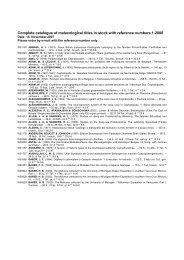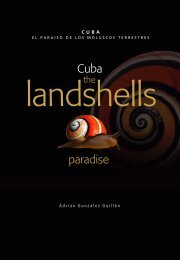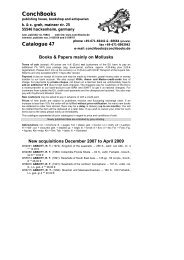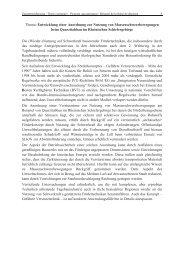Madeira Canary Islands Azores – Fishes Dr. Peter Wirtz
Madeira Canary Islands Azores – Fishes Dr. Peter Wirtz
Madeira Canary Islands Azores – Fishes Dr. Peter Wirtz
You also want an ePaper? Increase the reach of your titles
YUMPU automatically turns print PDFs into web optimized ePapers that Google loves.
Triggerfishes (Balistidae) 138<br />
Filefishes (Monacanthidae) 140<br />
Pufferfishes (Tetraodontidae) 142<br />
Porcupine fishes (Diodontidae) 144<br />
Sunfishes (Molidae) 144<br />
The blissful islands<br />
The „Macaronesian <strong>Islands</strong>“ are not <strong>–</strong> as one might suspect <strong>–</strong> somewhere in the Pacific Ocean. The German<br />
botanist A. Engler coined this name in 1879 for the <strong>Azores</strong>, <strong>Madeira</strong> (plus Porto Santo) and the <strong>Canary</strong><br />
<strong>Islands</strong>, because of similarities in the plants of the plant species of these islands. The name comes from the<br />
Greek (makaros, nesios) and means „the blissful islands“. Later, many authors (probably for political<br />
reasons) also counted the Cape Verde <strong>Islands</strong> among the Macaronesian <strong>Islands</strong> but from a biological point of<br />
view this is not justified: the animal and plant life of the Cape Verde <strong>Islands</strong> is much more similar to tropical<br />
Africa than to the true Macaronesian <strong>Islands</strong>. Three fish species (Raja maderensis, Gobius maderensis and<br />
Scorpaena canariensis) live only around the Macaronesian <strong>Islands</strong> and nowhere else. The Blue Wrasse<br />
Centrolabrus caeruleus lives only at the <strong>Azores</strong>. Two rare and small gobies are currently only known from the<br />
<strong>Canary</strong> <strong>Islands</strong> (but may have been simply overlooked at other places until now).<br />
With a distance of 1300 km to the mainland, the <strong>Azores</strong> are the most remote islands in the northern Atlantic.<br />
One consequence of this isolated position is that there are only about 400 different species of fish at the<br />
<strong>Azores</strong> (about 550 each at <strong>Madeira</strong> and the Canaries): some shore fish did not succeed to bridge such a large<br />
distance. The speciose family Sparidae (breams) provides a good example: whereas there are 24 different<br />
bream species at the <strong>Canary</strong> <strong>Islands</strong>, and 15 at <strong>Madeira</strong>, only 8 are recorded from the <strong>Azores</strong>.<br />
All Macaronesian <strong>Islands</strong> have a volcanic origin. Coming from a depth of sometimes several thousand meters,<br />
these volcanoes break through the surface of the sea with but their tips. There are many more volcanoes in the<br />
same area, which do not reach the surface; however, some of them were also islands with terrestrial animals<br />
and plants in former times, when the sea level was about 120 m lower than today.









